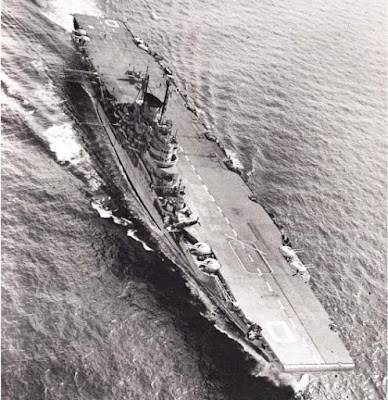HMS Illustrious (87) was a British aircraft carrier used by the Royal Navy during World War II. She carried out combat missions in the Mediterranean, the Indian, and the Pacific Theater of Operations. Sailing the waters of the Mediterranean Sea, HMS Illustrious played a key role in the Battle of Taranto, in 1940, when the Fairey Swordfish torpedo bombers took off from her deck and attacked the Italian fleet moored at their naval base of Taranto. As a result, several Italian ships were sunk and seriously damaged. During this armed conflict, she would win five awards and honors. She was the lead ship of her class, which also included HMS Victorious (38) and HMS Formidable (67).
HMS Illustrious (87) was designed at the end of 1936, when the British Admiralty invited bids for the construction of two aircraft carriers. Vickers Armstrongs' bid were accepted, with a £ 2,395,000 budget/cost. She was laid down on April 27, 1937, at Barrow shipyard, England. She would be launched two years later, on April 5, 1939, and commissioned on May 25, 1940. Because of the war, Illustrious' flying trials were the shortest on record. She was assigned to the Mediterranean Fleet, sailing for the island of Malta with 21 Fairey Swordfish torpedo bombers, 7 Fairey Fulmar reconnaissance/fighters, and 5 Blackburn Skua dive-bombers.
Technical Characteristics
HMS Illustrious (87) was the first aircraft carrier in any navy to be built with an armored hangar, which granted it greatly increased protection against air attacks. However, the weight of the armor allowed the ship to have only one hangar. The flight deck was originally 620 ft (189 m) long, but later it would be increased to 740 ft (226 m), while the width was 95 ft (29 m). The flight deck was served by two elevators. The fact that it was strongly armored allowed her to survive eight bombs when she was attacked off Crete on January 10, 1941. One catapult was fitted on the port side of flight deck, which had a double-reeved arresting wire across it.
At the island, the bridge was reinforced with bullet-proof plates to protect the officers against enemy aircraft strafe. The main armored deck, protecting ammunition, machinery, and fuel stowage, was 3-inch (75-mm) thick. The main belt protecting the carrier consisted of 4 1/2-inch (115-mm)-thick welded steel plates. The main mast of the island was fitted with a Type 281 aerial radar, while the ship's power plant consisted of three Parsons geared steam turbines, with three shafts, supplied by six boilers. The air group was originally composed of 33 aircraft, but, by 1944, the number of combat aircraft had been increased to 52.
Specifications
Displacement: 23,000 tons (29,240 tons full-loaded)
Length: 740 feet (226 m)
Beam: 95 feet (29 m)
Draft: 28 feet, 10 inches (8.7 m )
Propulsion: 3 Parsons geared steam turbines, 3 shafts, and 6 boilers, generating 110,000 SHP.
Maximum Speed: 30.5 knots
Armament: sixteen 114-mm AA and forty eight 2-pdr AA guns.
Aircraft: 52 (33 originally). In the Pacific, she carried 20 F4U Corsairs and 16 Avengers.
Compliment: originally 1,229 sailors an officers; 1,997 by 1944.
Below, the HMS Illustrious sailing on the Atlantic in June 1940, right before being assigned to the Mediterranean Fleet.
The Illustrious in 1946, after the war. By then, her hull had been remade at her extremities as the flight deck had been lengthened, with the forward run-down completely re-shaped.
Below, the mighty British aircraft in July 1939, during trials.
The coat of arms of the Illustrious.








